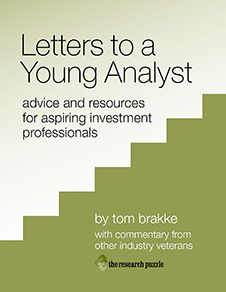
- Wednesday, September 7th, 2016
- the tests ahead
-
In the aftermath of the financial crisis, there was a great hue and cry about how we had become slaves to our models and that they had proven to be imperfect — tragically imperfect — masters.
It is, then, quite ironic (and very surprising, at least to me) that we seem to be more reliant on those models than ever before. Well, perhaps not those models, but the new-and-improved ones that have taken their place.
The investment business has gotten more quantitative and more automated, so that’s certainly part of it. It’s hard to become more qualitative in your approach and more thoughtful about the proper context in which models should be used when you’re handing off much of the decision/execution process to machines.the research puzzle | Here’s a posting that considers “programmed” versus “nonprogrammed” decisions.
The financial crisis was a watershed event for investment organizations, as you might expect. Significant changes in decision making processes have been put in place in the last few years at many of those organizations, and they haven’t really been tested. Oh, sure, we’ve had a few squalls here and there, but nothing like a real storm.
The changes invariably revolve around new risk models and a greater appreciation for and attention to the management of “risk.” I put the word in quotes, because when asked to define it, investment professionals are very good about describing the multi-dimensional nature of risk, but the models they employ are focused almost exclusively on the management of volatility. And those models are being used up to (and past) their reasonable limits, trusted to provide the rudder for a full-steam-ahead push for returns in a low-return environment. “Working harder, using extra levers,” as someone at a notable firm explained to me.
It’s possible that these new models are being used with a greater appreciation for their potential failings, part of a more prudent application of the next generation of tools. But it sure doesn’t sound that way. When you ask questions, you find that the stress tests being performed are focused on a predictable list of past crises (just as they always have been).
A qualitative exploration of risks and an emphasis on exploring and preparing for unexpected scenarios are still lacking, just like they were before the last crisis and the crisis before that. It’s the real weak spot in most “risk management” endeavors.
As I was learning about the models being employed at another big-name organization, I was told that the data that propels them goes all the way back to 1983, “and that’s a very long time.” That happens to be the year I started in the investment business. It seems like a long time in some ways (although where did all that time go?), but it really isn’t.
It has all been part of one economic regime of lower inflation, lower interest rates, and globablization, accompanied by a flood of assets into the investment industry and the erection of the superstructures of practice and belief that grew along with it. It’s really not much of a slice of history — yet that’s the limited window that supports most investment recommendations and plans.
If we think about the four “deep risks” for investors identified by William Bernstein,Efficient Frontier | Here’s a brief description and link to the book. to what extent does our current practice deal with any of them?
Deflation? Not really at all;
Inflation? To a certain extent, but not very comprehensively, since we are so far removed from it;
Devastation? That’s hard to predict, of course, although we could help prepare ourselves by thinking carefully about the probabilities of certain events and modeling the effects of them; or
Confiscation? Not much, although, it being the political season, you don’t have to go far to get a conspiracy theory if you’re looking for one.
Instead, we focus on the shallow risk of volatility and claim to have discovered ways to conquer it. And we largely ignore the very powerful risk that lies between the shallow and deep ones — that of paying too much for assets. Everyone plans to dynamically sidestep the risks as they show up rather than exhibiting prudent behavior in advance.
There is a fairly new phrase that has gained popularity rather quickly: evidence-based investing. In fact, there’s an upcoming conferenceIMN | The event is being put on by IMN and Ritholtz Wealth Managment. on the topic that features a bunch of leading lights (and one puzzler). But what evidence do we have? And how do we think about it? That is the main thing that I will want to hear about at the conference.
Because I believe that the evidence is skimpier than we think. Certainly there are principles that endure and practices that will make sense over any reasonable length of time (don’t pay too much in fees, don’t chase returns, etc.). But when it comes to the returns, correlations, volatilities, and relationships that we can expect, I think the range of possibilities is far wider than most of us can imagine, which is not the spirit with which investment products (or “solutions”) are built or marketed these days.
“All models are wrong, but some models are useful,” my teaching partner used to say. It seems that we are back to believing too heartily in our models and their output. That doesn’t mean that we have to throw them away or discount them into meaninglessness. But we certainly need to spend more time thinking about how they will be wrong — because they will be — and how we can capture their value in our decision making despite that fact.
Right now, there’s more hubris than humility in the discussion of risk management and investing in general, and little real imagination about the tests that lie ahead.
